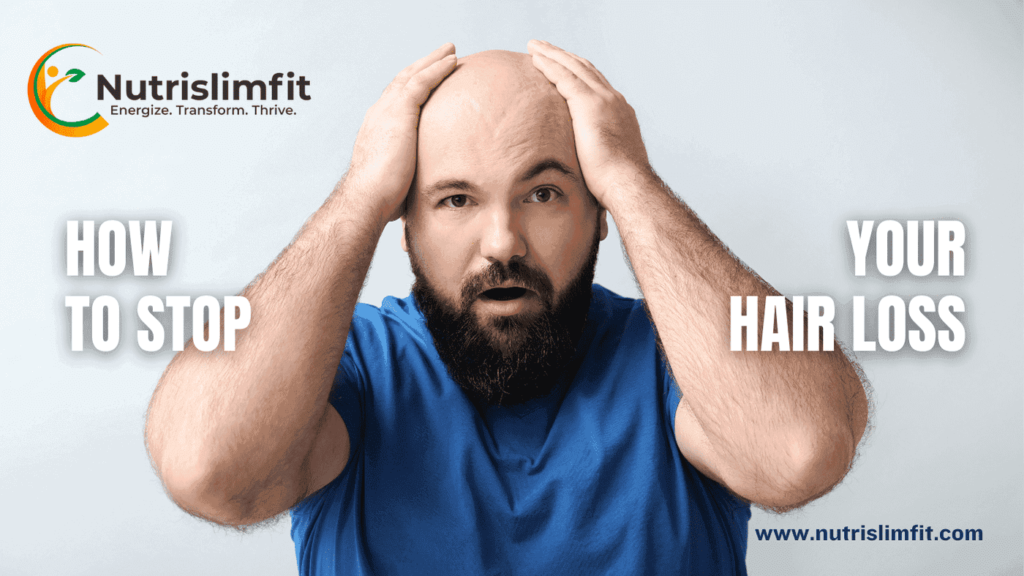Hair loss can be distressing, but there are many ways to treat it. This comprehensive guide covers the various causes of hair loss, how How to Stop Hair Loss, and evidence-based conventional and natural treatments, tips for living with hair loss, and frequently asked questions.

What Causes Hair Loss?
There are several potential causes of hair loss:
Male and Female Pattern Baldness
Also called androgenetic alopecia, this is the most common type of hair loss. It’s hereditary and caused by hormones. Over time, hair follicles shrink, producing thinner hairs that eventually fall out. It usually follows a predictable pattern.
In men, it often starts with a receding hairline and a bald spot on the crown. In women, it starts with thinning hair on the top of the head.
Alopecia Areata
This autoimmune disorder causes patchy hair loss. Hair falls out in small, round patches which can connect to form larger bald patches if left untreated. It can lead to total hair loss (alopecia totalis) or complete body hair loss (alopecia universalis), but this is rare.
Traction Alopecia
This is caused by damage from hairstyles that pull on the hair, like tight braids, cornrows, pigtails, or extensions. The constant tension damages follicles, leading to inflammation and hair loss. Removing the cause allows hair to regrow.
Trichotillomania
This psychological condition causes people to compulsively pull out their hair. It’s often triggered by stress or boredom and done unconsciously. This can cause patchy hair loss or thinning hair. Treating the underlying psychological cause can allow hair regrowth.
Nutrient Deficiencies
Lacking key vitamins and minerals like iron, zinc, and protein can hinder hair growth and trigger excessive shedding, diffuse thinning, or loss of body hair. Correcting deficiencies with diet, supplements or medication allows hair to recover.
Medications and Medical Conditions
Hair loss can occur as a side effect of medications, like blood thinners, antidepressants, and medications for heart disease. Autoimmune diseases, thyroid disorders, and illnesses like syphilis can also trigger temporary or permanent hair loss.
Childbirth
Some women experience hair shedding 3-6 months after pregnancy due to estrogen levels rapidly dropping back to normal. Typically the hair grows back normally if the cause is just postpartum hormonal changes.
Age-Related Hair Loss
As we get older, hair growth slows down and hair follicles shrink, causing thinner hair. Typically this mild thinning due to aging doesn’t start until your 50s or later. Getting gray hair early on doesn’t necessarily mean you’ll go bald faster.
Stress-Related Hair Loss
High-stress levels put hair follicles in a resting phase, leading to excessive shedding about 3 months later once the stress event has passed. Hair growth usually rebounds once the stress is under control. Sudden traumatic events can also trigger thinning.
When to See a Doctor
See your doctor or dermatologist if:
- You’re losing hair rapidly or extensively
- You have pain, itching, burning, or other sensations in bald patches
- Bald patches are caused by something you suspect is serious like an infection
- Hair loss is causing you psychological distress
- Self-care isn’t helping regrow hair
Testing can help diagnose the cause, rule out conditions like infection, and determine appropriate treatment. Seeing a doctor promptly gives you the best chance of stopping hair loss before it progresses.
Conventional Medical Treatments
Hair Transplants
This surgical procedure is the most effective conventional treatment for male and female pattern baldness. Multiple hair grafts are harvested from thicker areas of the scalp and implanted into thinning areas. Transplants work best if the balding areas still have some existing hair. As hair keeps thinning, multiple transplants may be needed over time.
Hairpieces and Extensions
Integrating hair extensions, wigs, and hair systems offers a fast and customizable solution for covering visible hair loss without waiting months for hair to regrow. Quality hairpieces today have very natural looks and seamless blending with existing hair. Custom-fitted options like vacuum wigs don’t slip or come off easily like old-fashioned wigs used to, allowing active lifestyles.
Evidence-Based Natural Remedies
Natural remedies have a lower risk profile compared to medications but can still produce meaningful improvements in hair regrowth. They require diligent, sustained use for a few months to notice results. We have the best evidence for:
Saw Palmetto Extract Supplements
Saw palmetto supplements block the production of DHT, a hormone contributing to pattern baldness. Multiple clinical trials have found that saw palmetto extract (spearmint tea can also help) leads to a small but noticeable improvement in hair count and quality within 4-6 months.
Scalp Massage
Massaging any bald or thinning areas with a few drops of stimulating essential oils like rosemary, peppermint, lavender, or thyme boosts circulation. This nourishes hair follicles for optimal growth. Perform gentle 5-10 minute massages daily.
A Healthy Balanced Diet
Focus your diet on incorporating foods scientifically proven to promote hair growth due to their vitamin, mineral, and antioxidant content:
- Lean meats
- Fish
- Eggs
- Nuts and seeds
- Legumes
- Colorful Fruits and Vegetables
- Whole grains
Getting enough protein is also crucial to maintain a robust hair growth rate. A generalized daily target is 0.36 grams of protein per pound that you weigh (or 0.8 grams per kg). The time any supplements accordingly with meals.
Stress Management Techniques
Chronic stress generates excessive cortisol and inflammatory chemicals that restrict blood vessels supplying hair follicles. This directly inhibits the anagen-growing phase.
Relaxation practices like meditation, yoga, therapeutic massage, and daily exercise curb anxiety while enhancing blood circulation for growth. Support groups, sufficient sleep, and counseling can also temper the effects of serious life stressors.
Tips for Coping and Living With Hair Loss
- Get styling tips from blogs, YouTube, or hair loss forums on flattering cuts that make thinning less obvious. Short styles, face-framing layering, and asymmetry help balance facial features.
- Try volumizing sprays, mousses, gels, root powders, and texturizing products to make the hair appear thicker. Color-tinted dry shampoos also conceal visible scalp between hairs.
- Use eyebrow pencils, serums, microblading, and tints to make brows look fuller as they frame the face.
- Apply scalp camouflages like Toppix or Nanogen fibers during the day. They instantly adhere to hairs along the part line, masking the appearance of thinning hair.
- You have countless options for semi-permanent or ready-to-wear custom hair systems if you want to cover bald areas. Many have lace fronts and appear convincingly real even up close. Hair toppers are another lightweight choice.
- Save and exchange any current strands of hair to have custom wigs or hair systems made later on if hair loss progresses. Companies can precisely match color, texture, density, and any highlights or grays. This offers continuity if you want your hairpieces to emulate how your hair looked before losing it.
Frequently Asked Questions
Does wearing hats, helmets or tight hairstyles cause baldness?
Wearing anything that puts pressure on hairs only causes traction alopecia thinning in areas where force is consistently applied. Hats themselves don’t make you go bald or directly damage hair health. Unless tied too tightly, ponytails also won’t lead to overall pattern baldness – just breakage along sections pulled taut.
Does shaving bald or cutting hair often make it grow back thicker?
No, this is just an illusion. Shaving hair does not affect how thick or fast it regrows. Each strand simply grows from the follicle beneath the scalp at its genetically programmed thickness, no matter how often it’s cut. However, new growth may seem fuller for a couple of days as short hairs stand straight up before getting weighed down. Frequent trims do keep split ends at bay to prevent tangles and breakage.
Will hair lost to male pattern baldness ever regrow without transplants?
Unfortunately, hair follicles sensitive to DHT will continue producing progressively thinner hairs that eventually don’t make it to the scalp’s surface. The follicle itself shrivels up over time without treatment. Restoring hair other than hair transplantation requires continuously using medications like finasteride or minoxidil to preserve and revive the follicles before they die off completely. Stopping treatment will allow hair loss to resume.
Does scalp cleaning or massage remove sebum and dead skin to reduce hair loss?
Gently massaging any balding areas with natural oils stimulates blood flow to feed follicles. However, harshly scrubbing or over-washing doesn’t clean away DHT or remove sebaceous oils and skin cells strongly enough to impact how hair follicles function. Using everyday shampoos to keep follicles unclogged is sufficient – no special products or handling are necessary during washing.
Are saltwater sprays safe for making hair fuller?
Homemade salt sprays can dry out and brittle hair since they have no emollients or conditioners. Water’s evaporating pulls moisture from the hair shaft, causing damage over time, especially if struggling with breakage already. Instead, use deeply conditioning masks monthly and breakage-reducing products containing fatty alcohols, silicones, shea butter, or coconut oil to fortify hair. These help minimize split ends and tangling that accompanies breakage-prone hair. Silicone-based thickening sprays also safely plump up strands instantly.
Can I still color or chemically straighten thinning hair?
Yes, as long as the right techniques and care are used:
- Space out coloring to 6-8 weeks to limit processing damage causing more shedding. Use semi-permanent or demi-permanent options.
- Apply root touch-up pens just where needed instead of re-coloring all hair.
- Use the gentlest straightening method and the lowest temperature setting suited for your hair type.
- Thoroughly coat hair with a protein filler beforehand.
- Always use conditioning treatments designed for damaged, color-treated hair.
- Adjust heat styling to lower temperatures and less direct heat.
- Gently pat dry instead of rubbing wet hair with towels. Detangle from the bottom up with a wide-tooth comb.
- Get regular trims to prevent tangling split ends since that causes more hair to come out when brushing.
With extra TLC, you can typically still achieve the style you want without excess shedding.
When should I consider a hairpiece instead of waiting for natural regrowth?
If your hair loss impacts your self-confidence or daily comfort level, immediately explore hairpieces before reaching an emotional tipping point. Hiding visible hair loss boosts confidence. Attempting regrowth can take almost 6 months to confirm if the chosen treatments work for your type of thinning. It’s easier to embrace temporary solutions first rather than become depressed over feeling forced to live with unwanted bald spots or sparse coverage in the meantime. You deserve to feel your best every day regardless of what stage you’re at with natural hair growth remedies.
What’s the ideal daily protein intake for optimizing hair growth?
Most healthy adults need around 0.36 grams of protein per pound that they weigh to maintain the ideal hair production cycle. This equates to 65-80 grams of protein spaced throughout meals for the average person. Focus particularly on eating nutrient-rich sources like eggs, fatty fish, beans, yogurt, nuts, seeds, lean poultry, and meats. Vegetarians may need to aim closer to the higher end of the intake.
The Bottom Line
Hair loss can have emotional and psychological effects for both men and women, impacting self-esteem and quality of life. The good news is that there are many treatment options available, both conventional and natural. Being proactive by seeing a doctor ASAP gives you the greatest chance of stopping progressive thinning or bald patches early on. Consistently using evidence-backed treatments and remedies can help encourage regrowth, potentially reversing hair loss entirely in some cases. There are also excellent cosmetic solutions for concealing hair loss as you undergo treatment. With the right game plan tailored to your specific type and pattern of hair loss, significant improvement is often achievable.


